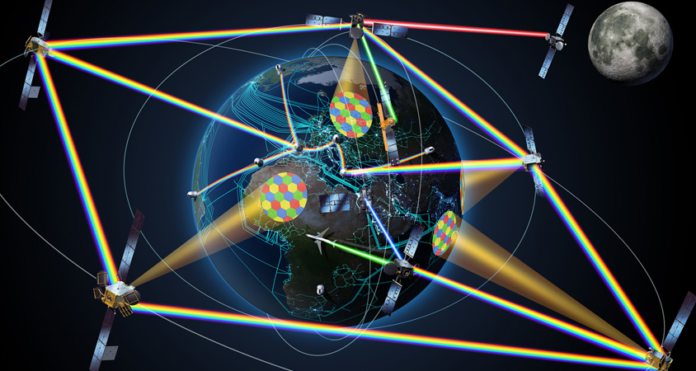
Optical communication also called optical telecommunication traces back its history from the year 1792. A French engineer named Claude Chappe succeeded in covering France with a network of almost 4,812 kilometers. With time technology evolved and its applications increased. In this blog, we will understand the myriad of applications of optical satellite communication and its market scenario.
Applications of optical satellite communication: –
- Backhauling
Backhaul refers to the part of a satellite network that serves as an intermediate between the main network and the small network used for distribution to other smaller channels. Backhaul solutions can mainly be categorized into 2 parts.
- Wired (leased lines or copper/fiber)
- Wireless (point-to-point, point-to-multipoint over high capacity)
The fiber optic backhaul uses plastic fibers to transmit data as pulses of light. The technology offers high capacity, minimal signal loss, and low latency. This makes it ideal for long-distance communications and high-performance networks. As per Research Nester’s survey, the revenue for wireless systems will be 2.65 Billion by 2024.
- Surveillance and security
Various companies are launching satellites manufactured to communicate with other satellites with the use of light-based optical inter-satellite links. The optical inter-satellite links to send information between themselves instantly and securely. It has a development approach that is agile and its optical inter-satellite link technology is efficient. As per our survey, the number of operational satellites in Earth’s orbit launched in 2020 were 3370.
- Monitoring and tracking
The researchers are expanding their tracking capabilities to make various efficient optical tracking of LEO objects at scale. In recent times, various companies are launching LEO to GEO optical satellite tracking and monitoring service.
- Earth observation
Various companies are accelerating the development of data relay satellites. These satellites incorporate optical inter-satellite communication services in the commercial sector. The goal of developing these satellites is to resolve the bottleneck of telecommunication with the use of optical links.
The telecommunication segment is expected to flourish in the market because of the application of tracking & monitoring and space exploration. There is rising demand for broadcasting services which is leading to higher market growth.
Optical Satellite Communication Industry Market Analysis:
The global optical satellite communication market generated a revenue of USD 1.5 billion in the year 2022 and it is anticipated to reach USD 1.8 billion by the year 2030.
With the utilization of optical communication in numerous data relay satellites is a remarkable application for the optical satellite communication industry market. There has been the development of portable ground stations, which is the newest trend in optical satellites. The optical material makes the product small and easy to transport and this makes them impeccable for executing field operations.
A recent example is from the European Space Agency used a device that is the portable optical ground station (OGS-1). It developed a link of communication with the satellite within an altitude of approximately 600 km.
The driving factors for the market are written as follows:
- The technological advancements in the domain of space and research are the prominent reason for the rising market growth
The optical communication utilizes laser beams to translocate data between the ground stations and satellites. The technology is becoming extremely popular on the back of capability of high bandwidth capabilities and prowess to eradicate interference. Various market players are focusing on developing projects related to optical satellite communications on the back of numerous advantages.
- There has been the development of ground infrastructure to support optical satellite communication
It has been witnessed that ground stations are a very important component of the optical communication system. There is advancement in optical communication technology and development in the ground stations has become significantly important to ensure the system operates effectively.
Regional Insights:
The North America region is expected to hold the largest market share in the year 2022. The reason for this is the widespread adoption of optical communication satellites in the North America region. Furthermore, the adoption of optical communication satellites is due to widespread space exploration all over the world. In fact, Europe is also projected to hold the second-largest market share on the back of numerous applications with specialized properties. The governments are utilizing these properties of optical communication for scientific and military purposes in which extremely high-power lasers are utilized.
Other than this, the market in the Asia Pacific region is also anticipated to garner remarkable growth during the forecast period. There are numerous technical advancements in the region and the market is projected to grow during the forecast period. The key companies in the market are written as follows:
- Ball Corporation
- Honey well international Inc
- NEC Corporation
- Starlink
- Tersat Space GmbH & Co KG
- Laser Light Communications
Key Trends in the Market: –
The ESA which is an acronym for European Space Agency has made a contract with a prominent company named Surrey Satellite Technology Ltd. The agreement is done to render additional communication services from a prominent company name Lunar Pathfinder.
Another news is from Ball Aerospace celebrated with NASA and shared its image with the public.
In a nutshell,
It is quite evident that the market is anticipated to garner remarkable growth and it’s prudent to invest in it. Although, knowing the imperative parameters of the market is also crucial to make sound decisions.


















